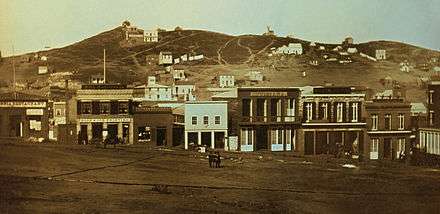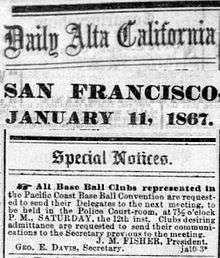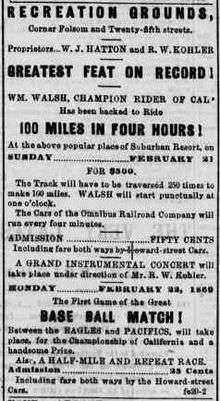List of baseball parks in San Francisco
Early history of baseball in San Francisco, California.
Portsmouth Square

It has been speculated that the game of baseball was played in California by men during the Gold Rush of 1849 when Alexander Cartwright, who is sometimes referred to as "the father of baseball", came to San Francisco and is reported to have brought his baseball to the city in 1849.[1][2] The Daily Alta California newspaper reports a game of base ball being played upon the Plaza (Portsmouth Square) "by a number of the sporting gentlemen about town", on February 3, 1851.[3] Mention of the play of a game of Townball at Portmouth Square is recorded in The Daily Alta California newspaper on January 14, 1852.[1][4] An early town leader serving on the city council as second alcalde, or assistant mayor, of San Francisco during the years 1849-1854 was Frank Turk a New York Knickerbocker.[1][5] According to historian Frank Joel, baseball was formally introduced into California, at San Francisco in 1859.[6]
The beginning years, 1860s

In the 1860s baseball grew in prominence in San Francisco, with the first game reported to be between the Eagles and the Red Rovers on February 22, 1860.[2] The San Francisco Directory in 1860 identifies three base ball clubs, the Eagle, Em Quad, and Excelsior Clubs.[7] In 1867 it was reported that "baseball clubs are now the rage" and the game of baseball drew plaudits from influential quarters. That year marked the establishment of the first baseball league in San Francisco known as the Pacific Coast Base Ball Convention with play 14 clubs from San Francisco, Oakland and Santa Clara county. The San Francisco clubs were named the Eagles, Pacifics, Lafayettes, Knickerbockers, Atlantics, Bay City, Empires, Brodericks[8] and the Cosmopolitans. The 1867 championship game, between the Atlantic and Cosmopolitan clubs, was won by the Cosmopolitans by a score 50 to 45 on April 27, 1867.[9] In the 1870s additional teams were named the Libertys, Wide Awakes (Oakland), Alhambra, Americans, Excelciors and the San Franciscos.[10]
First baseball park, Recreation Grounds

California's and San Francisco's first enclosed professional baseball park, located in the heavily Irish workingman Mission District, was named simply 'The Recreation Grounds' and opened November 26, 1868 [11][12][13][14] and operated until November 23, 1884.[15] Built on the site of the Pioneer Race Course, a horse race track owned by George Treat, and the facility was used for multi-purposes including base ball games and cricket matches as early as October 1860.[16] The grandstand accommodated initially a capacity of 12,000 fans and was later expanded to hold 17,000.[17] Home of the Pacific Baseball League beginning in 1878, was owned an operated by the politically active Captain Al Fritz of the influential Workingman's Party of California in partnership with Samuel Shear on land leased from San Francisco Mayor Andrew J. Bryant.[18] In the later years after the death of Fritz, the Recreation Grounds was leased by Waller Walace and Andy Pierce for organized ball play with the preeminent team of that era being the Haverlys.[19] In 1879 league play included a new Military League, organized by newspaper reporter Joseph H. McCloskey, drawn from teams of local militias which were generally aligned along ethnic lines.[20] The period of 1881 to 1886 saw league play from the California League which failed to achieve much organizational competence, during the year 1883 for instance, there was only 36 games among four teams.[21]
The location of this ballpark bordered Harrison, Twenty-Fifth, Folsom and Twenty-Sixth Streets, including present day Garfield Square. Photo. Other teams playing in Recreation Grounds included the Eagles, Wide Awakes, Niantics, Woonsockets and the Reddingtons. 37°45′2.63″N 122°24′49.33″W / 37.7507306°N 122.4137028°W
Amateur and practice fields

19th Century amateur and practice fields. During the 1870s and 1880s baseball was a very popular recreation in San Francisco with amateur games and practices held prior to professional games at the professional parks, and at fields located at 15th and Folsom, 25th and Howard in the Mission District, at 8th and Harrison South of Market and at Filmore and Geary in the Richmond.[22] A sand lot baseball field was located at Pierce and Haight Streets, 1886 photo.
Haight Street Grounds
Haight-Street Recreation Grounds. Following a league dispute at the Central Park grounds, James Fair established a new ball park in 1886 known as the Alameda Grounds on the island of Alameda for play of the California League, which was moved the following year for play at a new baseball park in the Haight District. With grandstands seating 14,000 and located at the terminus of a railcar line.[23][24] 1887 to March 1895. The borders of this ball park were Stanyan, Waller, Cole and Frederic Streets Photo.[25] Teams playing in this park included the Greenhood & Morans both of Oakand, the Colonels of the California League (1887–89), the Haverlys andFriscoes - California League (1887–1893), the San Franciscos - California State League (1896 only), Brewers - California League (1897–1901) and the Pirates - Pacific National League (1903). 37°46′3.17″N 122°27′5.46″W / 37.7675472°N 122.4515167°W
Central Park
1884-1906 In the South of Market district, known under the name 'Central Park' at the corner of 8th and Market Streets, a stadium with seating for 15,000, Daniel R. McNeil opened a professional baseball stadium on Thanksgiving Day 1884,[26] and was used for play of the Pacific Coast Baseball League from 1886 until June 1887.[27] 37°46′25.81″N 122°24′30.79″W / 37.7738361°N 122.4085528°W
This ball park on April 28, 1888 became the home of the newly formed California State League.[28][29][30] This park was destroyed by 1906 earthquake/fire.
- Location: 8th and Market Streets 1901 Photo.
- Occupants:
- San Francisco Seals - Pacific Coast League (1903-1906 part)
Recreation Park

Mission District Recreation Park April 6, 1907 until 1930.[31] - 1930s 37°46′1.87″N 122°25′23.93″W / 37.7671861°N 122.4233139°W
- Occupants:
- San Francisco Seals - Pacific Coast League (1907–13, 1915–30)
- Oakland Oaks - Pacific Coast League (1907–12)
- ?San Francisco Baby Seals - California Baseball League (1910 only)
- Mission Reds - PCL (1914 only)
- ?San Francisco - California State League (1915 only)
- Mission Reds - PCL (1926–30)
- Location: 14th Street (north, right field); Valencia Street (east, first base); 15th Street (south, third base); Guerrero Street (west, left field) Photo.
- Currently: Housing project
Ewing Field
Ewing Field, 1914 to 1938 (located in the Richmond District, on Masonic between Geary and Turk; the Seals played at Ewing Field for one year in 1914, but returned to the Valencia Street Recreation Park the next year following many criticisms of the cold, windy, foggy weather at Ewing Field)[32][33][34][35][36] In June 1926 the stadium burned down from a fire started by a cigarette.[37] From 1926 until 1938 the field remained unoccupied.[37]
- Occupant: San Francisco Seals - Pacific Coast League (1914)
- Location: Masonic Avenue (east, third base); St. Rose's Avenue (now Anza Street, north, first base)
- Currently: Ewing Terrace (street and housing development)
Seals Stadium
- Seals Stadium 1931 through 1959
- Occupants:
- San Francisco Seals - Pacific Coast League (1931-57)
- Mission Reds - PCL (1931-37)
- San Francisco Giants - National League (1958-59)
- Location: Bryant Street (west, first base); 16th Street (south, right field); Potrero Avenue (east, left field); Alameda Street (north, third base)
- Currently: Potrero Center, a shopping mall
Candlestick Park
- Candlestick Park April 12, 1960 to September 30, 1999
- Occupant: San Francisco Giants - National League (1960-1999)
- Location: 602 Jamestown Avenue
AT&T Park
- AT&T Park March 31, 2000 – present
- Occupant: San Francisco Giants - National League (2000-present)
- Location: 24 Willie Mays Place
See also
Sources
- 1 2 3 Hank Greenwald; Nelson, Kevin (2004). The Golden Game: The Story of California Baseball. Berkeley, Calif: Heyday Books. pp. 6, 7. ISBN 1-890771-80-5.
- 1 2 Franks, Joel (2001). Whose baseball?: the national pastime and cultural diversity in California, 1859-1941. Issue 19 of American sports history series. Scarecrow Press. p. 31. ISBN 978-0-8108-3927-4. ISBN 0-8108-3927-X.
- ↑ Daily Alta California, Volume 2, Number 56 (page 2, column2), 4 February 1851
- ↑ Daily Alta California, Volume 3, Number 13 (page 2, column4), 14 January 1852.
- ↑ "San Francisco Genealogy - San Francisco Official Roll 1846-1894". Retrieved 2009-11-05.
- ↑ Franks, Joel (2001). Whose baseball?: the national pastime and cultural diversity in California, 1859-1941. Issue 19 of American sports history series. Scarecrow Press. p. 10. ISBN 978-0-8108-3927-4. ISBN 0-8108-3927-X.
- ↑ San Francisco Directory page 462, 1860
- ↑ Franks, Joel (2001). Whose baseball?: the national pastime and cultural diversity in California, 1859-1941. Issue 19 of American sports history series. Scarecrow Press. pp. 33–34, 36. ISBN 978-0-8108-3927-4. ISBN 0-8108-3927-X.
- ↑ Daily Alta California, Volume 19, Number 6253, 28 April 1867
- ↑ Franks, Joel (2001). Whose baseball?: the national pastime and cultural diversity in California, 1859-1941. Issue 19 of American sports history series. Scarecrow Press. pp. 36–37. ISBN 978-0-8108-3927-4. ISBN 0-8108-3927-X.
- ↑ "The San Francisco Call newspaper, July 7, 1907.". p. 4. Retrieved 2009-09-05.
- ↑ "Sacramento daily record-union newspaper. (Sacramento [Calif.]) May 9, 1884". p. 5. Retrieved 2009-09-05.
- ↑ Zinngg, Paul J.. Harry Hooper: An American Baseball Life Sport and Society, Page 46, University of Illinois Press, 2004 ISBN 978-0-252-07170-6
- ↑ "The Chronology - 1868 | BaseballLibrary.com". Retrieved 2009-09-10.
- ↑ Daily Alta California newspaper, Volume 37, pg 1, Number 12643, 24 November 1884
- ↑ Daily Alta California, Volume 12, Number 3890, 7 October 1860
- ↑ Elias, Robert (2001). Baseball and the American dream: race, class, gender, and the national pastime. Armonk, N.Y: M.E. Sharpe. p. 155. ISBN 0-7656-0763-8.
- ↑ Franks, Joel (2001). Whose baseball?: the national pastime and cultural diversity in California, 1859-1941. Issue 19 of American sports history series. Scarecrow Press. pp. 43–44. ISBN 978-0-8108-3927-4. ISBN 0-8108-3927-X.
- ↑ Franks, Joel (2001). Whose baseball?: the national pastime and cultural diversity in California, 1859-1941. Issue 19 of American sports history series. Scarecrow Press. p. 56. ISBN 978-0-8108-3927-4. ISBN 0-8108-3927-X.
- ↑ Franks, Joel (2001). Whose baseball?: the national pastime and cultural diversity in California, 1859-1941. Issue 19 of American sports history series. Scarecrow Press. pp. 50–51. ISBN 978-0-8108-3927-4. ISBN 0-8108-3927-X.
- ↑ Franks, Joel (2001). Whose baseball?: the national pastime and cultural diversity in California, 1859-1941. Issue 19 of American sports history series. Scarecrow Press. p. 54. ISBN 978-0-8108-3927-4. ISBN 0-8108-3927-X.
- ↑ Franks, Joel (2001). Whose baseball?: the national pastime and cultural diversity in California, 1859-1941. Issue 19 of American sports history series. Scarecrow Press. p. 84. ISBN 978-0-8108-3927-4. ISBN 0-8108-3927-X.
- ↑ Franks, Joel (2001). Whose baseball?: the national pastime and cultural diversity in California, 1859-1941. Issue 19 of American sports history series. Scarecrow Press. pp. 60, 64, 84. ISBN 978-0-8108-3927-4. ISBN 0-8108-3927-X.
- ↑ FoundSF.org
- ↑ "The San Francisco Morning Call newspaper, March 1, 1895.". Retrieved 2009-09-05.
- ↑ Daily Alta California newspaper, Volume 37, Number 12601, pg 8, 13 October 1884
- ↑ Franks, Joel (2001). Whose baseball?: the national pastime and cultural diversity in California, 1859-1941. Issue 19 of American sports history series. Scarecrow Press. pp. 56, 59–60. ISBN 978-0-8108-3927-4. ISBN 0-8108-3927-X.
- ↑ Franks, Joel (2001). Whose baseball?: the national pastime and cultural diversity in California, 1859-1941. Issue 19 of American sports history series. Scarecrow Press. p. 62. ISBN 978-0-8108-3927-4. ISBN 0-8108-3927-X.
- ↑ San Francisco Chronicle, September 21, 1897 page 7.
- ↑ San Francisco Chronicle, October 31, 1897 page 20.
- ↑ Nelson, Kevin (2004). The golden game: the story of California baseball. Heyday Books. p. 74. ISBN 978-1-890771-80-5. Retrieved October 7, 2009.
- ↑ Franks, Joel (2001). Whose baseball?: the national pastime and cultural diversity in California, 1859-1941. Issue 19 of American sports history series. Scarecrow Press. p. 216. ISBN 978-0-8108-3927-4. ISBN 0-8108-3927-X.
- ↑ Gaar, Greg. "Ewing Field: Lost in the Fog Bank". Western Neighborhoods Project. Retrieved 16 March 2016.
- ↑ Macfarlane, Angus. "Ewing Field: Better than Make-Believe, Part 1". Western Neighborhoods Project. Retrieved 16 March 2016.
- ↑ Macfarlane, Angus. "Ewing Field: Better than Make-Believe, Part 2". Western Neighborhoods Project. Retrieved 16 March 2016.
- ↑ MacFarlane, Angus. "Ewing Field". FoundSF. Retrieved 16 March 2016.
- 1 2 "The Story Of Ewing Field, NoPa's Doomed Stadium Of Yesteryear". Hoodline. Retrieved 2016-08-26.
- Peter Filichia, Professional Baseball Franchises, Facts on File, 1993.
- Phil Lowry, Green Cathedrals, several editions.
- Michael Benson, Ballparks of North America, McFarland, 1989.